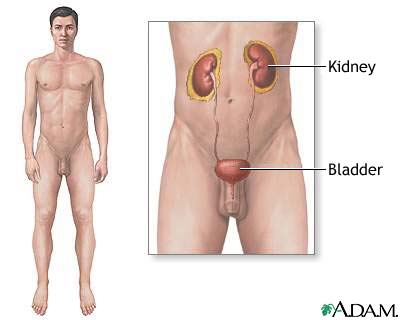Symptoms & Signs
The disorder damages the tiny blood vessels in the kidneys, called glomeruli, that filter wastes.
At first, there are no symptoms. However, progressive destruction of the glomeruli leads to blood in the urine and may decrease the effectiveness of the kidney’s filtering system. There is a progressive loss of kidney function and a build-up of fluids and waste products in the body.
In women, the disorder is usually mild, with minimal or no symptoms. In men, the symptoms are more severe and get worse faster.
Symptoms include:
* Abnormal urine color
* Ankle, feet, and leg swelling
* Blood in the urine
* Decrease or loss of vision, more common in males
* Loss of hearing, more common in males
* Swelling around the eyes
* Swelling, overall
The condition can progress to end-stage renal disease (ESRD) at an early age (between adolescence and age 40).
Note: There may be no symptoms in some cases. Symptoms of chronic kidney failure or heart failure may be present or may develop.

Diagnosis & Tests
* Changes to the eye, including the fundus (posterior inner part of eye), lens, cataracts, or lens protrusion (lenticonus)
* Elevated blood pressure
* Tiny amounts of blood in the urine (microscopic hematuria)
The following tests may be done:
* Urinalysis shows blood, protein, and other abnormalities.
* BUN and creatinine are elevated.
* Red blood cell count, hematocrit may decrease.
* Audiometry may show nerve deafness.
* Renal biopsy shows chronic glomerulonephritis with changes typical of Alport syndrome.
Alport syndrome: Overview, Causes
Alport syndrome: Symptoms & Signs, Diagnosis & Tests
Alport syndrome: Treatment
Review Date : 11/30/2009
Reviewed By : David C. Dugdale, III, MD, Professor of Medicine, Division of General Medicine, Department of Medicine, University of Washington School of Medicine; Herbert Y. Lin, MD, PHD, Nephrologist, Massachusetts General Hospital; Associate Professor of Medicine, Harvard Medical School. Also reviewed by David Zieve, MD, MHA, Medical Director, A.D.A.M., Inc.
